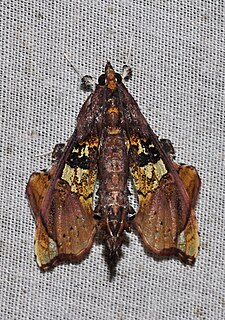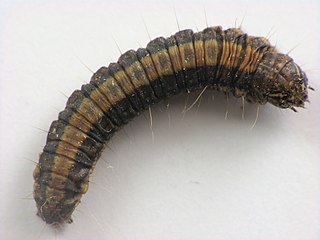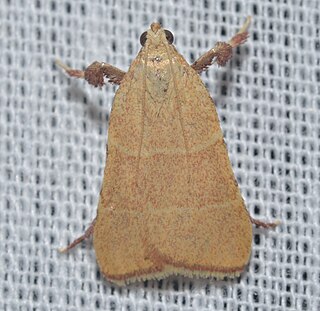Related Research Articles

George H. Walker was an American trader and politician who helped found the city of Milwaukee, Wisconsin. He served as the 5th and 7th Mayor of Milwaukee, and represented Milwaukee in the Wisconsin State Assembly and its predecessor body in the Wisconsin Territory.

Crambinae is a large subfamily of the lepidopteran family Crambidae, the crambid snout moths. It currently includes over 1,800 species worldwide. The larvae are root feeders or stem borers, mostly on grasses. A few species are pests of sod grasses, maize, sugar cane, rice, and other Poaceae. The monophyly of this group is supported by the structure of the tympanal organs and the phallus attached medially to the juxta.

Hypena is a genus of moths in the family Erebidae. It was first described by Franz von Paula Schrank in 1802. These non-migratory moths overwinter as pupae and almost never come to bait as adults.
Arxama is a genus of moths of the family Crambidae.

Glaucocharis is a genus of moths of the family Crambidae described by Edward Meyrick in 1938.
Liopasia is a genus of moths of the family Crambidae.

Lygropia is a genus of snout moths in the subfamily Spilomelinae of the family Crambidae. It currently comprises 66 species, which are mostly found in the tropical and subtropical regions of the Americas, Africa and Asia, but not in Australia.

Pyrausta is a speciose genus of moths of the family Crambidae. The genus was erected by Franz von Paula Schrank in 1802.

Syllepte is a genus of moths of the family Crambidae.

Terastia is a genus of snout moths in the subfamily Spilomelinae of the family Crambidae. It was described by Achille Guenée in 1854 with Terastia meticulosalis as type species. The genus is currently placed in the tribe Margaroniini, where it is closely related to the genera Agathodes and Liopasia.

Eupitheciini is a tribe of geometer moths under subfamily Larentiinae, often referred to as pugs. The tribe was described by Tutt in 1896.

The Chrysauginae are a subfamily of snout moths. They are primarily Neotropical and include about 400 described species.

The Epipaschiinae are a subfamily of snout moths. Almost 600 species are known today, which are found mainly in the tropics and subtropics. Some occur in temperate regions, but the subfamily is apparently completely absent from Europe, at least as native species. A few Epipaschiinae are crop pests that may occasionally become economically significant.
Emmalocera is a genus of snout moths. It was described by Émile Louis Ragonot in 1888.
Glaucocharis ochracealis is a moth in the family Crambidae. It was described by Francis Walker in 1866. It is found in Australia, where it has been recorded from New South Wales.
Pyrausta ochracealis is a moth in the family Crambidae. It was described by Francis Walker in 1866. It is found in Sri Lanka, India (Assam), Myanmar, Java and Sulawesi.
Liopasia apicenotata is a moth in the family Crambidae. It was described by George Hampson in 1918. It is found in Trinidad.
Liopasia puseyalis is a moth in the family Crambidae. It was described by Schaus in 1920. It is found in Peru.

Parachma ochracealis is a species of pyralid moth in the family Pyralidae.

Margaroniini is a tribe of the species-rich subfamily Spilomelinae in the pyraloid moth family Crambidae. The tribe was erected by Charles Swinhoe and Everard Charles Cotes in 1889.
References
- ↑ Nuss, M.; et al. (2003–2014). "GlobIZ search". Global Information System on Pyraloidea. Retrieved 2014-07-15.
- ↑ Savela, Markku. "Liopasia ochracealis (Walker, [1866])". Lepidoptera and Some Other Life Forms. Retrieved January 28, 2018.
| This Margaroniini-related article is a stub. You can help Wikipedia by expanding it. |